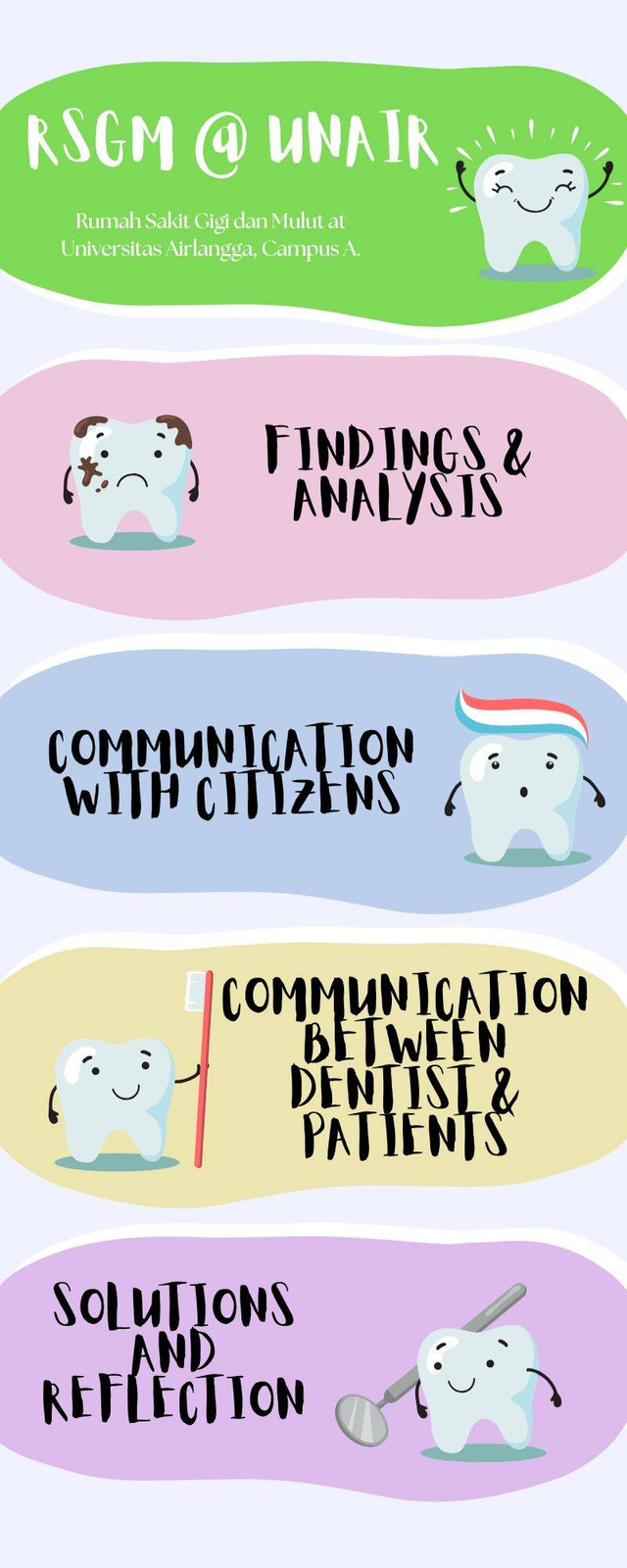Tentang KamiPedoman Media SiberKetentuan & Kebijakan PrivasiPanduan KomunitasPeringkat PenulisCara Menulis di kumparanInformasi Kerja SamaBantuanIklanKarir
2025 © PT Dynamo Media Network
Version 1.103.0
Konten dari Pengguna
Implementation of Therapeutic and Effective Communication in the Health Sector
16 Desember 2024 16:05 WIB
·
waktu baca 5 menitTulisan dari Zahra Fazreen tidak mewakili pandangan dari redaksi kumparan

ADVERTISEMENT
Abstract
This essay will highlight my experience visiting a dental hospital, namely Rumah Sakit Gigi dan Mulut at Universitas Airlangga (RSGM UNAIR). This visit allowed me to observe how communication plays an important role in the healthcare system. From the waiting room to the treatment area, verbal and non-verbal communication interactions plays a key role in creating a sense of trust, clarity, and understanding between healthcare professionals and patients.
ADVERTISEMENT
Introduction - Interprofessional Health Communication
Interprofessional health communication is a term used to refer the exchange of information among health professionals. This is important as it plays a huge role in collaboration, respect and understanding, patient-centred focus and problem solving. The interactions among the clinic staff, including dentists, nurses, and receptionists is important as these benefits not only patients but also the working environment. A therapeutic and effective exchange of verbal and non-verbal communication can aid in building trust, enhance understanding, improve patient outcomes, prevent misunderstanding and strengthen professional reputation.
Findings and Analysis
RSGM consist of 52 hospital room and 49 specialist doctors, making effective communication crucial for a healthy work environment. Effective interprofessional communication not only promotes collaboration within healthcare workers but also patient outcomes. For instance, dentists rely on nurses to prepare tools and maintain patient comfort, often using directive communication to demonstrated their efficiency. Additionally, non-verbal cues such as head nods or pointing gestures are also used.
ADVERTISEMENT
Communication With Citizens
At the information desk, I observed that the communication between the administrative staff and patients were less clinical yet equally important. The receptionist greeted potential patients with respect and warmth by using a calm tone and attentive body language. They explained payment procedures and follow up appointments clearly. Furthermore, when dealing with elderly patients or those with language barriers, they spoke slowly and used simple language. The body language observed, such as leaning forward to show attentiveness or smiling, created a welcoming environment. It is important as even a brief moment of impatience could leave a negative impression on patients.
Communication Between the Dentist and Patients
ADVERTISEMENT
The interaction between dentists and patients was a blend of professionalism and compassion. Dentists used clear verbal communication to explain treatment plans, procedures and diagnoses. The dentist often used simple terms when explaining verbally. For instance, instead of saying “dental carries or “gingivitis”, they said “tooth decay” or “gum inflammation”. This approach made dental concepts easy to understand and this is considered effective information exchange. Moreover, non-verbal communication also played a significant role. The dentist would maintain consistent eye contact, nodded to show understanding, and even used reassuring gestures, such as gentle touches on the shoulder and smiles. This type of non-verbal communication can ensure comfort to anxious patients. Positive body language and a calm tone can further ease patient’s worries, especially among children or those undergoing complex/invasive procedures.
ADVERTISEMENT
Challenges and Observations
However, one notable challenge that I observed was the communication gap, this is due to the language barrier between the patient and the health worker and staff at the reception desk. Some patients with limited literacy and fluency in Bahasa Indonesia struggled to understand instructions or treatment plans, which led to frustration on both sides. This highlighted the importance of tailoring communication styles to individual needs. Additionally, while most interactions were positive, there were times of rushed explanations due to busy hours. This could leave patients feeling uninformed or not understood.
Solution
One potential solution to combat this challenge is to leverage on technology, such as using devices with translation software, as this could aid in enhancing clarity and reduce misunderstandings. Moreover, offering written instructions in multiple languages can also aid with language barrier. Overall, by implementing these strategies, healthcare workers or staff can ensure that every patient, regardless of their race, religion or language proficiency feels valued, understood, and respected.
ADVERTISEMENT
Reflection
Upon reflection, it is evident to see that communication in healthcare must be a two-way interaction. Effective communication in healthcare goes beyond simply sharing information; it is about fostering trust, showing empathy and ensuring mutual understanding. A healthcare workers ability to balance verbal clarity with empathetic non-verbal cues is vital. Encouraging patients to ask questions and express concerns is also just as important as providing clear and accurate information. Moreover, addressing language and cultural barriers is equally crucial in creating an inclusive and supportive environment for all patients.
Conclusion
In conclusion, this task allowed me to observe how effective and therapeutic communication in a dental clinic plays a vital role in healthcare. My experience at RSGM taught me that communication is not just an important soft skill to have but also is the foundation of delivering quality health services. Addressing these challenges and combating the problems is crucial to enhance patient care. It is important to have mutual respect, show empathy, be audible with clarity and humble to ensure patient centred care. Lastly, effective communication is the bridge between technical expertise and compassionate care.
ADVERTISEMENT

